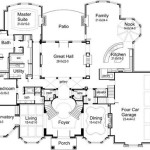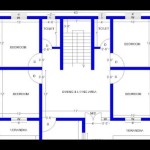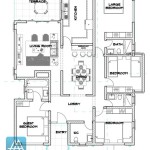How Do I Find The Floor Plan Of My Property?
Locating the floor plan of a property can be crucial for various reasons, ranging from planning renovations and interior design to simply understanding the layout for furniture placement or emergency preparedness. The availability of a floor plan can save significant time and effort when undertaking property-related projects. However, the process of finding this document is not always straightforward. This article will outline the various avenues one can explore to obtain a floor plan for their property.
The difficulty in finding a property's floor plan often stems from the fact that it is not always a readily available or centrally stored document. Unlike property deeds or tax records, floor plans are not systematically recorded in a public database for every property. They might be created during the initial construction phase, renovation projects, or for marketing purposes during a sale or lease. Consequently, the search often involves contacting various entities or meticulously examining existing property documents.
Successfully locating a floor plan hinges on understanding where such documents are likely to be stored, who might possess a copy, and the legal frameworks that govern access to property information. The strategies detailed in this article offer a comprehensive approach to navigating these complexities and ultimately retrieving the desired floor plan.
1. Checking Existing Property Documents and Records
The first and often most accessible place to begin the search for a floor plan is within the existing documents associated with the property. These records might contain information that directly includes a floor plan or indirectly leads to its discovery.
Review the purchase agreement or closing documents from when the property was acquired. These documents sometimes include a basic floor plan, particularly if the property was newly constructed at the time of purchase. While not always comprehensive, this plan can provide a starting point for understanding the property's layout.
Mortgage documents may also contain a floor plan, especially if the mortgage was obtained during or after a renovation project. Lenders sometimes require a floor plan to assess the value of the property after improvements have been made. Scrutinize any appraisals or surveys conducted during the mortgage process, as these often include a detailed layout of the property.
Building permits and related documentation are another valuable source. When renovations or additions are undertaken, permits are generally required, and the application process often necessitates submitting a floor plan. Contact the local building department or planning office to inquire about accessing these records. Be prepared to provide the property address and any other relevant details, such as the approximate date of the renovations. Access to these documents may be subject to local regulations and privacy laws, so understanding the specific requirements of the jurisdiction is essential.
Insurance policies, particularly those covering structural damage, can sometimes include a simplified floor plan. Insurance companies may use floor plans as part of their risk assessment process. Reviewing the insurance policy documents and contacting the insurance provider could yield a copy of a floor plan.
Finally, check personal records. Past renovation plans, architectural drawings, or even marketing materials from when the property was listed for sale or rent could contain a floor plan. Organize and thoroughly examine any stored documents related to the property to identify potential floor plan sources.
2. Contacting Relevant Professionals and Organizations
If existing documents do not yield a floor plan, the next step is to contact professionals or organizations who may have created or retained such documents. This approach requires a proactive effort to identify and communicate with potentially knowledgeable parties.
Reach out to the original builder or developer of the property. If the property is part of a planned community or was built by a specific construction company, they might have retained the original floor plans. Even if the original builder is no longer in business, their records might have been transferred to a successor company or archived by a related organization. Researching the history of the property's construction can help identify the relevant builder or developer.
Contact the architect or designer who worked on the property, particularly if any significant renovations or additions have been undertaken. Architects are required to keep records of their projects for a certain period, and they may be willing to provide a copy of the floor plan. If the architect is no longer practicing, their records might have been passed on to another firm or archived by an architectural association.
Real estate agents who have previously listed the property for sale or rent are another potential source. Real estate listings often include a floor plan as part of the marketing materials. Contacting the agents who handled previous transactions and requesting a copy of the floor plan from the listing can be a productive approach. Online real estate portals may also have archived listings that include floor plans.
Homeowners associations (HOAs) or property management companies sometimes maintain records of properties within their jurisdiction, including floor plans. Contact the HOA or property management company for the property and inquire about the availability of floor plans. Be prepared to provide proof of ownership or residency to access these records.
Local historical societies or archives may also possess floor plans, particularly for older properties. These organizations often collect and preserve historical documents related to buildings and properties in the area. Researching the property's history and contacting local historical societies can uncover valuable information, including floor plans.
3. Exploring Municipal and Government Resources
Local municipal and government entities often possess records related to properties within their jurisdiction. These resources can be valuable sources of floor plans, although accessing them may require navigating bureaucratic processes and complying with specific regulations.
Visit the local building department or planning office. As mentioned earlier, building permits and related documentation often include floor plans. The building department is typically responsible for reviewing and approving building plans, and they may have archived records of past projects. Contacting the building department and requesting access to these records can be a fruitful approach. Be prepared to provide the property address and any other relevant details, such as the approximate date of any renovations.
Consult property tax records. While property tax records typically do not include detailed floor plans, they may contain a basic sketch of the property's layout or dimensions. This sketch can be a useful starting point for creating a more detailed floor plan. Property tax records are usually publicly accessible, either online or at the local tax assessor's office.
Explore online mapping services and geographic information systems (GIS). Some municipalities have implemented online mapping services that provide detailed information about properties, including building footprints and dimensions. These services may not provide a complete floor plan, but they can offer valuable insights into the property's layout.
Investigate the local land registry or recorder's office. While not always a source of floor plans, the land registry may have records of surveys or plats that include basic property layouts. These documents can be helpful in understanding the property's boundaries and the location of buildings on the land.
Consider freedom of information (FOI) requests. In many jurisdictions, individuals have the right to access government records, including building permits and plans. Submitting a formal FOI request to the relevant municipal or government agency can compel them to provide access to the requested documents, subject to certain exemptions and limitations. Research the specific FOI laws and procedures in the local jurisdiction before submitting a request.
Navigating municipal and government resources can be challenging, as access to information is often subject to specific regulations and procedures. Perseverance and a clear understanding of the local rules are essential for successfully obtaining a floor plan through these channels.
In cases where a floor plan cannot be found through the methods described above, the final recourse may be to create a new floor plan. This process typically involves hiring a professional surveyor or architect to measure the property and create a detailed drawing of the layout. This option can be costly, but it ensures that an accurate and up-to-date floor plan is available for future use.
The choice of which avenue to pursue will largely depend on the age of the property, the type of renovations that have been undertaken, and the availability of resources. Combining multiple search strategies can increase the likelihood of success in locating the desired floor plan.

10 Ways To Find The Floor Plan Of A House

How To Find Floor Plans Blue Prints Of Your House

How To Find Floor Plans Blue Prints Of Your House

9 Ways To Find Floor Plans Of An Existing House Archid

How To Obtain A Site Plan Of My Property Cedreo

How To Obtain A Site Plan Of My Property Cedreo

How To Read A Floor Plan With Dimensions Houseplans Blog Com

12 Examples Of Floor Plans With Dimensions

Where You Can Buy House Plans Live Home 3d

How To Read A Floor Plan With Dimensions Houseplans Blog Com
Related Posts








